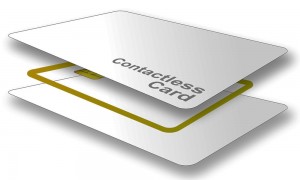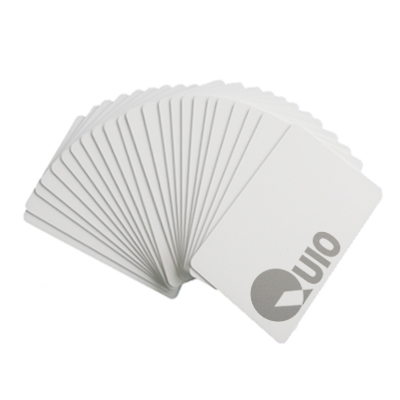RFID/NFC Cards
13.56 MHz |
125 KHz |
| F08 1K S50 low cost type |
TK4100 low cost type |
| Mifare 1K S50 | EM4200 |
| Fudan S70 low cost type |
|
| Mifare 4K S70 | |
| Icode SLI | EM4305 |
| Icode SLI-x | T5577 |
| Icode SLI-s | |
| Icode SLI-x2 | |
| Mifare Ultralight EV1 |
|
| Mifare Ultralight-C | |
| NTAG 213 |
|
| NTAG 215 | |
| NTAG 216 | |
| M4QT | |
| DesFire EV1 2K | |
| DesFire EV1 4K | |
| DesFire EV1 8K |
RFID cards are contactless chip cards that transmit information via radio waves (RFID = Radio Frequency Identification). The chip is inside the plastic card and is therefore protected from external influences such as dirt, moisture, heat or cold. This makes the RFID cards particularly insensitive and durable. The card data can be encrypted and thus protected against unauthorized access. Of course, the cards can also be coded and individually printed by us according to your specifications and wishes. You can get all common types of chips from us. NFC is a sub-category of RFID.
NFC in general
The NFC technology (Near Field Communication) connects the diverse contactless technologies and enables solutions in the areas such as information exchange and collection, access control, healthcare, entry control at major events, transport, payment processes and entertainment electronics.
NFC is an advanced form of RFID technology. NFC works on the basis of “two-way communication” and can thus be used for complex actions such as exchanging images and exchanging information. It can be read by millions of smartphones and other devices. The reading area of just a few centimeters ensures data security.
Overview of NTAG213, NTAG215 and NTAG216
NTAG213, NTAG215 and NTAG216 were developed as standard NFC tag IC-Kontakts that are intended to be used in combination with NFC devices. NTAG213, NTAG215 and NTAG216 fully meet the NFC Forum Type 2 Tag and ISO / IEC14443 Type A specifications.
Thanks to the high input capacitance, the NTAG tag IC-Kontakts are especially suitable for applications that require a small reception range without compromising on performance.
The advantage is the contactless energy and data transmission.
The high-speed HF communication interface enables the data to be transmitted at a baud rate of 106 kbit / s, with the right alignment.
The advantages:
- The fast read function makes it possible to scan the complete NDEF message with just one FAST_READ command, thus reducing overhead in high-performance production environments
- The improved RF performance allows more flexibility in the choice of shape, dimensions and material
The security:
- Manufacturer programmed 7-byte UID for each device
- Pre-programmed capacity container with one-time programmable bits
- Field programmable read-only lockout function
- ECC-based originality signature
- 32-bit password protection to prevent unauthorized storage operations
NFC Forum Day 2 type conformity
The NTAG tags provide full compliance with the NFC Forum Tag 2 type technical specification and enable NDEF data structure configurations.
Anti-collision function
The intelligent anti-collision function makes it possible to operate more than one day in the field at the same time. The anti-collision algorithm selects each day individually and ensures that the execution of a transaction with a selected day is carried out correctly without interference from another day in the field.
Characteristics
- Contactless data transmission and energy supply
- Operating frequency of 13.56 MHz
- Data transfer of 106 kbit / s
- Data integrity of 16-bit CRC, parity, bit coding, bit counting
- Operating distance up to 100 mm (depending on various parameters such as field strength and antenna geometry)
- 7-byte serial number (cascade level 2 according to ISO / IEC 14443-3)
- UID ASCII mirror for the automatic serialization of NDEF messages
- Automatic NFC counter triggered on read command
- NFC counter ASCII mirror to automatically add the NFC counter value to the NDEF message
- ECC-based originality signature
- True anti-collision
- 50 pF input capacitance
EEPROM
- 180, 540 or 924 bytes organized in 45, 135 or 231 pages with 4 bytes per page
- 144, 504 or 888 bytes freely available user read / write area (36, 126 or 222 pages)
- Data retention period of 10 years
- Endurance 100,000 write cycles





